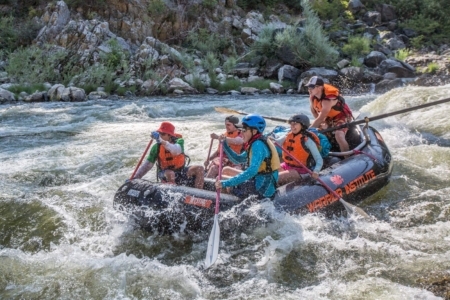Connecting Two Rivers: The Klamath and the Río Baker
At first glimpse, the Klamath River in the United States’ Pacific Northwest and the Río Baker in Chilean Patagonia, South America, seem to have nothing in common. Separated by more than 10,000 miles, their waters drain basins that are drastically different. One river begins in a sagebrush desert before weaving through rugged conifer-lined canyons; the other descends from glaciers and travels along the Patagonian ice fields. The Klamath drains an area the size of Switzerland, roughly 16,000 square miles; the Baker’s watershed is a little more than half of that but it boasts the largest surface flows in Chile.
They are different waterways flowing through different worlds. Until today.
As we breeze along the waters of the Klamath River, which begins its course in Oregon and ends in California, we accompany around 30 young adults. Nearly a dozen of them hail from Patagonia, in my home country of Chile. Through this exchange program run by the international nonprofit Ríos to Rivers, they cover 120 miles in three weeks, traveling by both raft and kayak. In that time, they prove something to be true: Despite the language barriers and cultural gap, the group has many things in common, and their rivers are indeed connected.
The Chilean youth, who traveled from the Patagonian villages of Cochrane and Tortel, have grown up with a strong bond to the Río Baker. The other adventurers, most of them Native Americans, come from families that have been living in the Klamath watershed along the Oregon-California border for millennia. The youth from both continents are intimately linked to their rivers, their ecosystems and a way of life sustained by the flow of the waterways. Both groups are fighting to protect free-flowing, clean and healthy waters.
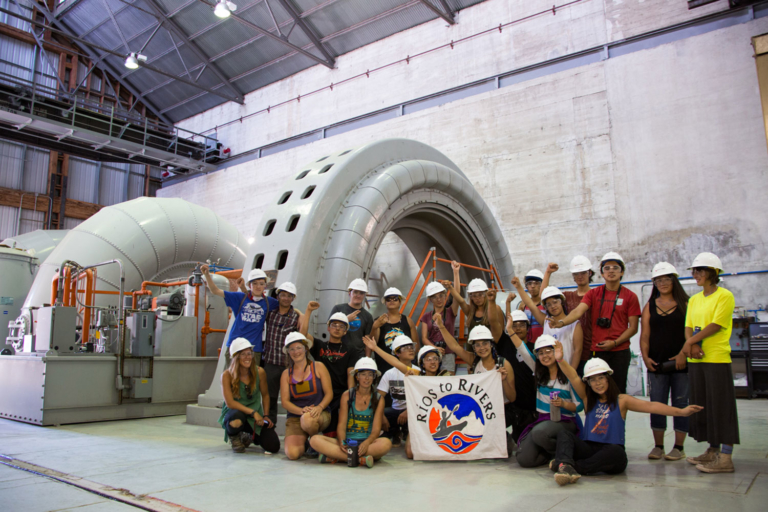
Students visit Copco Number 1 Dam, one of four Klamath River dams slated for removal in 2020 as part of the largest dam removal in history. This was the first time these youth from Patagonia, Chile, had ever seen a large-scale dam. Photo: Weston Boyles
Worlds Apart
The Klamath River watershed is characterized by its generous and magnificent nature. It has been inhabited for more than 10,000 years, sustaining tribes like the Klamath, the Karuk, the Hoopa and the Yurok, among others. Beginning in the 19th century, this same richness attracted various speculators, companies and industrial projects.
First came the hunters, in search of beaver pelts—and occasionally those of grizzly bears. In just a few years, these animals, fundamental for regulating the habitat, were extinct here. Then came the hombres de oro (gold prospectors), the timber companies and large-scale agriculture. With them came so-called progress: railroads, factories and then, of course, the dams—six along this one river. In short time this progress swept through the coastal redwoods, up through the dry pine forest and into the high desert basin’s oasis, drying up a large part of the wetlands that formed a transitory stop for millions of migratory birds.
The Klamath, which historically was known for having one of the richest systems for salmon production in the United States, felt the effects of development that resulted in poor water quality and increased prevalence of fish disease. The magnificent salmon that once ruled the Klamath are now just barely teetering on the edge of survival. Pink salmon have been eradicated, Coho are on the brink of extinction and this year’s fall Chinook run was predicted to be the lowest return on record, leaving almost no fish to sustain the Native people who have relied on salmon for millennia.
In my country, the Río Baker travels 110 miles from Lago General Carrera in the heart of Patagonia to the Pacific coastal village of Tortel. With its pristine waters and impressive flows, its watershed and that of the neighboring Río Pascua are recognized by the people of Chilean Patagonia as exceptional. These watersheds have defined the Patagonian region of Aysén as one of the last relics on the planet where nature exists in its wild state, creating an ecosystem marked by biodiversity, uniqueness and invaluable environment.
But these waters, their ecosystems and the way of life for thousands of Patagonians are being threatened. The HidroAysén megaproject was a plan by two major hydro companies to build five large dams in Patagonia: three on the Pascua and two on the Baker. The project was originally approved, but after massive social protests the permit was invalidated in 2014. And while last week, in a temporary victory for the Chilean people, the two companies (Enel and Colbún) decided to renounce their water rights, this does not mean these rivers are out of harm’s way. The water rights will now go back to the government, until the next hydro company comes along. Until Chile’s wild and scenic rivers are permanently protected, the Baker and other beautiful rivers in Chile will be at risk.
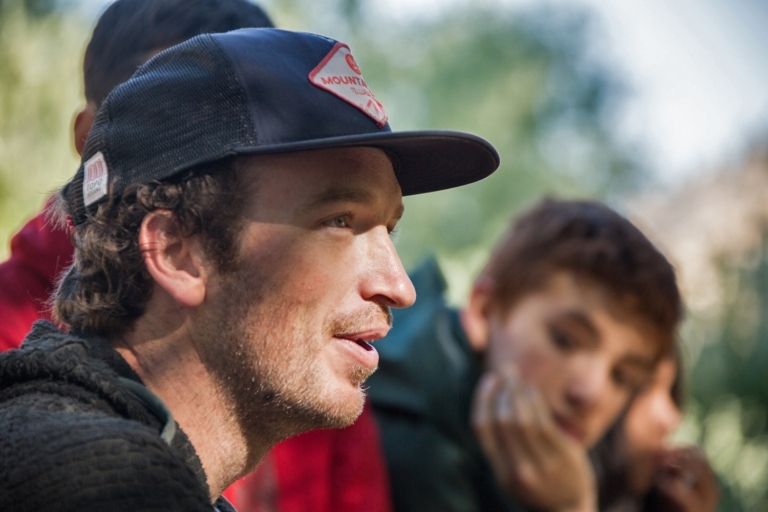
Motivated to help a group of young kayakers from Patagonia, Chile, protect their river from being dammed in 2012, Ríos to Rivers founder and director Weston Boyles has led many youth exchanges between the United States and Chile. Photo: Ben Lehman
Ríos to Rivers
It is in this socio-environmental context that the Ríos to Rivers NGO, in collaboration with the Warrior Institute, Ancestral Guard and Klamath Riverkeeper, decided to carry out the latest version of its Chilean-American environmental education program with a descent down the Klamath River.
Weston Boyles, the director of Ríos to Rivers and an American kayaker who lives in Chile’s Aysén region, describes how he founded the group “to train and educate young people in the care of rivers, in order to protect pristine ecosystems and contribute to the protection of degraded places, both in Patagonia and in the United States.”
Both cultures seem to be driving this exchange; the encounter between the young people becomes a chance to give voice to two rivers that historically have been disjointed.
For three weeks, the young paddlers travel down the waters of the Klamath, camping on remote river bars, sharing bread with peanut butter in the morning and a strong yerba mate in the afternoon. They exchange songs around the campfire and—through drawings, charades and a little help from translators—engage in seamless cross-cultural communication. The itinerary also unites the group through diverse educational activities. They tour four of the six Klamath River dams and reservoirs; they have the opportunity to hear presentations from fishery biologists and river ecologists; and they meet with diverse stakeholders in the basin. Along the river they are received by the heads of different tribes, learning about their customs and ways of life.
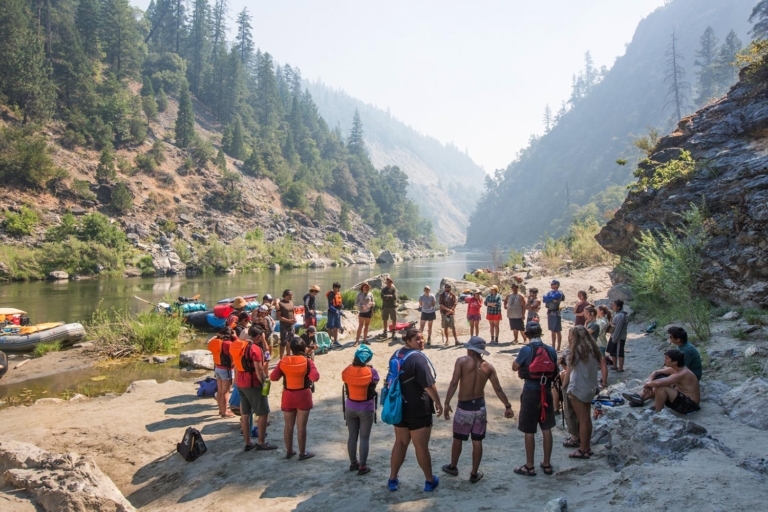
Students prepare to take part in a stream restoration project on Ukonom Creek, a tributary of the Klamath River. With a goal to empower the next generation of river stewards, the students participate in numerous leadership-building and hands-on-learning activities during the exchanges. Photo: Ben Lehman
Making History
For the South Americans, some of whom are traveling outside Chile for the first time, it is many intense days of adventure, learning and feedback. “In Patagonia, where we live, these things haven’t happened yet,” says Diego Delgado, from the village of Cochrane. “There are no dams and our rivers are clean and full of life and you can drink the water wherever you want. Before coming here we didn’t know how lucky we are to live in that little paradise. This trip has helped us a lot to understand and value what we have.”
But the story they’re living and want to tell the world is not so simple. It is not just about two rivers, one pristine and the other mutilated. As Boyles points out, “We chose the Klamath River as the site of this new exchange because this watershed is experiencing one of the most revolutionary transformations in U.S. history. By 2020 they are planning to dismantle four dams, making it the largest dam removal ever performed.”
This plan only came about in 2010, after a decade of protests, lawsuits and negotiations. The dam owner, PacifiCorp, reached an agreement with Klamath Basin Tribes, federal and state agencies, farmers and ranchers, and fishing and conservation groups. The U.S. Congress failed to ratify the original agreement, but the groups were able to amend that agreement in 2016. This allows them to remove the dams by 2020 without an act of Congress.
Currently in the United States, more dams are being removed than built, mainly due to the growing recognition of the high social and environmental cost they generate. Out of all this, the obvious question arises: Why do we continue to build new dams on one side of the world while on the other they are being dismantled?
Time Machine
John Luke Gensaw, a 19-year-old member of the Yurok Tribe, explains: “This exchange of Ríos to Rivers has been super powerful because it is like climbing into a time machine. If I could climb into a time machine, I would definitely go back and I would fight so that my river would not be destroyed. The rivers where our Chilean friends live have not yet been destroyed. I have the opportunity to fight with them and help them to try not to repeat the same mistakes.”
For these young Chileans, the idea of the time machine holds up. The Klamath is a future projection of their own rivers, if the fight to keep those rivers free-flowing is lost and dams are built in the future. Recognition of this interwoven reality created a profound affinity between the youth; as the days passed and the voyage came to an end, their stories became their cause, their opinions a common battle and their friendship sealed in brotherhood and sisterhood.
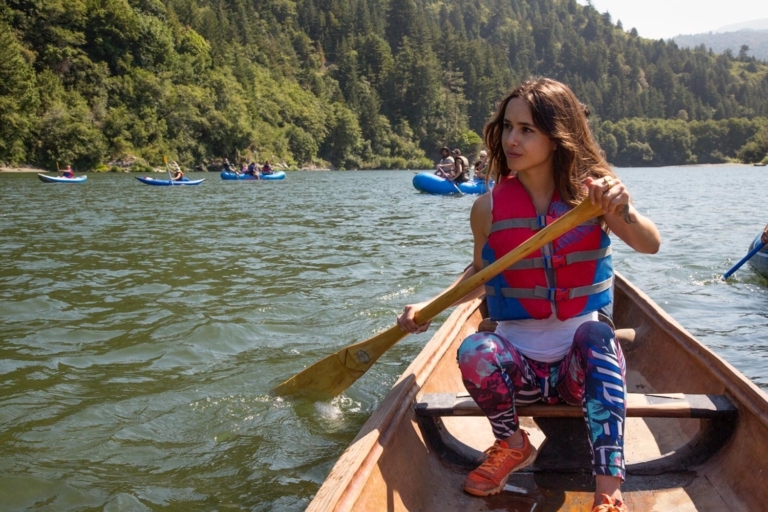
Chilean actress and activist Juanita Ringleing Vicuña paddles a traditional Yurok Tribe redwood dugout canoe to the final celebration with the Ríos to Rivers program in Requa, California. Photo: Weston Boyles
To the Sea
Thus arrived July 29. At about 3 o’clock in the afternoon the mouth of the Klamath River witnessed three traditional canoes, followed by dozens of rafts and kayaks. From Requa (the name given by the Yurok people for the part of the river where the Klamath joins the Pacific Ocean), the sweet voices sang a repetitive melody that flooded both the river and the sea, coming from the Yurok women who welcomed the adventurers. The litany, the coastal fog and multicolored banners painted by students the night before formed a singular and emboldened landscape.
The group landed; families, friends and local people were waiting for them with music, food and many questions. On the stage prepared for their arrival, the youth were able to share their ideas, tell stories and give thanks. The words of Alejandra Chodi, a 15-year-old from Tortel, resonate: “We are the fish that swim against the current, that fight against a wave of dams. We are the life in both free-flowing rivers and dammed ones, a current full of hope that delivers power to the cry of the people, because there are still tribes and gauchos withstanding the chains of power, who live to defend their lands and waters. We are all the Baker! We are all the Klamath!”
This is just the beginning of a great and profound journey. The culmination of this exchange, precisely at the place where the river meets the sea, symbolizes both the past and what will come. Like the estuary itself, with its blend of salt and fresh water generating a rich and abundant ecosystem, this combining of cultures produces tremendous energy and a renewed vision of hope. Out of this desire to arrive victoriously at the ocean, a determination has been forged: to spread the hopes and dreams for free-flowing rivers among fellow youth, children and other people, not just from their isolated hometowns, but from all over Chile, the United States and all throughout the world. Now is the time to act.
Ríos to Rivers is a 501(c)3 organization that inspires the protection of rivers through river-running, hands-on education and the support of outdoor programs. For more info and how you can support their exchange program please visit www.riostorivers.org.
